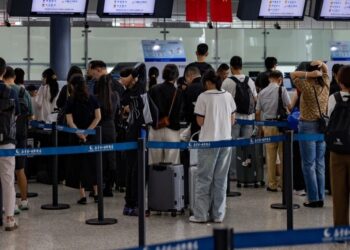
Two powerful typhoons, Neoguri and Ragasa, have reached super typhoon intensity by Sunday, bringing widespread rainfall to Southwest and South China as the region grapples with a delayed start to the clustered autumn typhoon season.
Typhoon Ragasa: A Super Typhoon Targeting South China
Typhoon Ragasa, the 18th of the year, intensified into a super typhoon late Saturday night. By 5 a.m. Sunday, it was positioned over the northwestern Pacific, approximately 770 kilometers northeast of Manila, the Philippines. At around 9:30 a.m. Sunday, its maximum sustained winds surged to 55 meters per second, making it the strongest typhoon in the western Pacific this year, according to weather.com.cn. Forecasters predict Ragasa will move northwest at 15 kilometers per hour, continuing to strengthen. It is expected to traverse the Bashi Channel on Monday and enter the northeastern South China Sea early Tuesday before heading toward the coast of Guangdong Province. From Tuesday to Thursday, the coastal waters and land areas of Guangdong will endure severe winds and heavy rainfall as a result.
Typhoon Neoguri: A Super Typhoon Moving Away from China
Meanwhile, the 19th typhoon of the year, Neoguri, strengthened into a super typhoon around 5 a.m. Sunday. Its center was located about 1,600 kilometers east-southeast of Tokyo, Japan, with maximum winds reaching 52 meters per second. Neoguri is forecast to move northwest at 15–20 kilometers per hour, further intensifying before gradually turning northeastward. After Tuesday, it is expected to have minimal impact on China’s offshore waters, CCTV reported.
Expert Warns of Unpredictable Landfall Risks
Ma Jun, director of the Institute of Public and Environmental Affairs, noted that July to October is typically the most active period for typhoons, with August and September being the peak months. While multiple landfalls are uncommon, powerful typhoons like Ragasa—whose tracks are highly unstable—make forecasting landfall locations especially challenging. This unpredictability significantly increases the potential impact, as even slight deviations in trajectory can lead to widespread damage.
Guangdong Prepares for Severe Disruptions
As Ragasa approaches, multiple cities in Guangdong have announced plans to suspend work, school, and public activities to mitigate risks. Key measures include:
- Guangzhou: The city’s districts are likely to issue a yellow typhoon warning starting Tuesday night, escalating to an orange warning for southern and central areas on Wednesday. School closures and work suspensions are expected.
- Shenzhen: The Emergency Management Bureau has confirmed Ragasa will be the strongest typhoon since 2018. All departments are on high alert, and “Five Suspension” measures (suspending school, work, production, transportation, and business) will be implemented if necessary.
- Zhuhai: From Tuesday to Wednesday, severe weather—including strong winds, heavy rain, and thunderstorms—is expected. Coastal areas may face significant storm surges. The city may enforce “Five Suspension” measures on Wednesday.
- Jiangmen: Due to Ragasa’s extreme strength and cold air from the north, severe weather is forecast for September 23–24. The city may issue “Five Suspension” measures, and residents are urged to stay updated on warnings.
- Chaozhou: The Meteorological Station predicts weather disruptions on September 24–25, with possible school and work suspensions. Parents and students are advised to prepare for changes.






